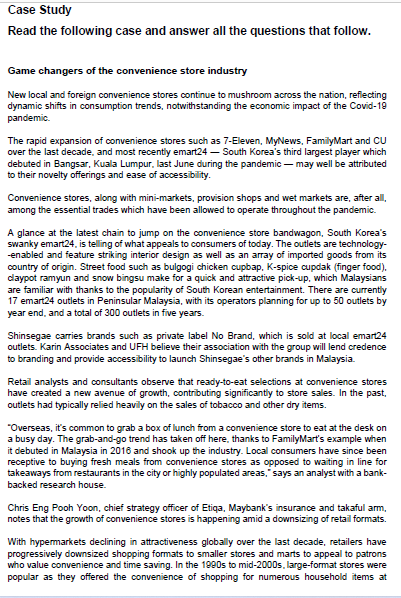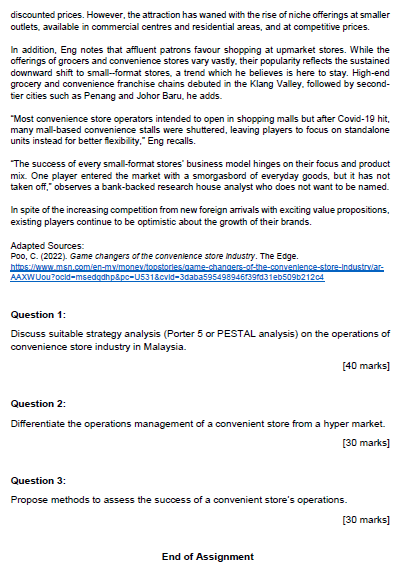

Case Study Read the following case and answer all the questions that follow. Game changers of the convenience store industry New local and foreign convenience stores continue to mushroom across the nation, reflecting dynamic shifts in consumption trends, notwithstanding the economic impact of the Covid-19 pandemic. The rapid expansion of convenience stores such as 7-Eleven, MyNews, FamilyMart and CU over the last decade, and most recently emart24 - South Korea's third largest player which debuted in Bangsar, Kuala Lumpur, last June during the pandemic - may well be attributed to their novelty offerings and ease of accessibility. Convenience stores, along with mini-markets, provision shops and wet markets are, after all, among the essential trades which have been allowed to operate throughout the pandemic. A glance at the latest chain to jump on the convenience store bandwagon, South Korea's swanky emart24, is tell ing of what appeals to consumers of today. The outlets are technology-enabled and feature striking interior design as well as an array of imported goods from its country of origin. Street food such as bulgogi chicken cupbap, K-spice cupdak (finger food), claypot ramyun and snow bingsu make for a quick and attractive pick-up, which Malaysians are familiar with thanks to the popularity of South Korean entertainment. There are currently 17 emart24 outlets in Peninsular Malaysia, with its operators planning for up to 50 outlets by year end, and a total of 300 outlets in five years. Shinsegae carries brands such as private label No Brand, which is sold at local emart24 outlets. Karin Associates and UFH believe their association with the group will lend credence to branding and provide accessibility to launch Shinsegae's other brands in Malaysia. Retail analysts and consultants observe that ready-to-eat selections at convenience stores have created a new avenue of growth, contributing significantly to store sales. In the past, outlets had typically relied heavily on the sales of tobacco and other dry items. "Overseas, it's common to grab a box of lunch from a convenience store to eat at the desk on a busy day. The grab-and-go trend has taken off here, thanks to FamilyMart's example when it debuted in Malaysia in 2016 and shook up the industry. Local consumers have since been receptive to buying fresh meals from convenience stores as opposed to waiting in line for takeaways from restaurants in the city or highly populated areas," says an analyst with a bankbacked research house. Chris Eng Pooh Yoon, chief strategy officer of Etiqa, Maybank's insurance and takaful arm, notes that the growth of convenience stores is happening amid a downsizing of retail formats. With hypermarkets declining in attractiveness globally over the last decade, retailers have progressively downsized shopping formats to smaller stores and marts to appeal to patrons who value convenience and time saving. In the 1990 s to mid-2000s, large-format stores were popular as they offered the convenience of shopping for numerous household items at discounted prices. However, the attraction has waned with the rise of niche offerings at smaller outlets, available in commercial centres and residential areas, and at competitive prices. In addition, Eng notes that affluent patrons favour shopping at upmarket stores. While the offerings of grocers and convenience stores vary vastly, their popularity reflects the sustained downward shift to small-format stores, a trend which he believes is here to stay. High-end grocery and convenience franchise chains debuted in the Klang Valley, followed by secondtier cities such as Penang and Johor Baru, he adds. "Most convenience store operators intended to open in shopping malls but after Covid-19 hit, many mal-based convenience stalls were shuttered, leaving players to focus on standalone units instead for better flexibility," Eng recalls. "The success of every small-format stores" business model hinges on their focus and product mix. One player entered the market with a smorgasbord of everyday goods, but it has not taken off," observes a bank-backed research house analyst who does not want to be named. In spite of the increasing competition from new foreign arrivals with exciting value propositions, existing players continue to be optimistic about the growth of their brands. Adapted Sources: Poo, C. (2022). Game changers of the convenience store industry. The Edge. AAXWUou?ocld-msedgdhp\&pC=U5318cvld-3daba595498946i39fd31eb509b212c4 Question 1: Discuss suitable strategy analysis (Porter 5 or PESTAL analysis) on the operations of convenience store industry in Malaysia. [40 marks] Question 2: Differentiate the operations management of a convenient store from a hyper market. [30 marks] Question 3: Propose methods to assess the success of a convenient store's operations








